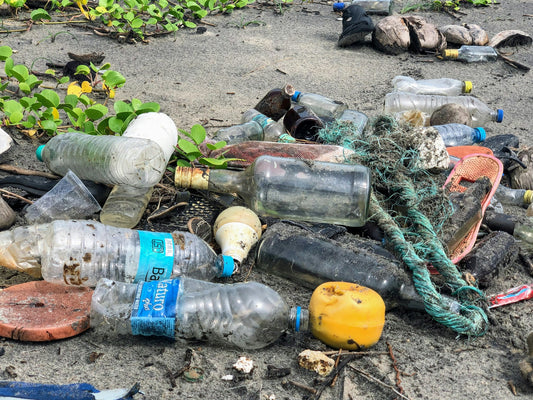Share
Recycling is hailed by many as the silver bullet against pollution.
The US Environmental Protection Agency for example writes on their website:
"Recycling provides many benefits to our environment. By recycling our materials, we create a healthier planet for ourselves and future generations. Conserve natural resources: Recycling reduces the need to extract resources such as timber, water, and minerals for new products."
But is recycling really the cure for our pollution problem? Let's find out and uncover the pros and cons of recycling.
What Actually is Recycling?
Generically speaking, recycling can be defined as the recovery and reprocessing of waste materials for use in new products.
What that entails is the collection of waste, processing that waste into new raw material, and then producing new products from the raw material that could again be recycled.
Most people know about mechanical recycling, which refers to grinding, washing, and reprocessing of materials. But there is also chemical recycling, which uses chemicals to break the material composition of the input material. Lastly, energy recycling focuses on incinerating materials for energy creation.
It is safe to say that mechanical recycling should be the choice wherever possible, because it has the least environmental impact.
Recycling rates are very different depending on the material, but the materials most frequently recycled are iron and steel scrap, aluminum cans, glass bottles, paper, wood, and plastics.
The idea of reusing waste and creating new products from it sure sounds great, doesn't it? Without a doubt, there are real arguments that speak for recycling.
The Pros of Recycling:

1. Resource Conservation
94% of the resources used by Americans are non-renewable. Resource preservation is one of the important issues of our time.
No matter the material that is being recycled, recycling helps conserve natural resources. Recycling paper preserves trees, recycling plastic means using less cude oil.
Recycling paper for example reduces the additional resource need to fill growing paper demand by 60% compared to not recycling.
2. Energy Conservation
The same applies to energy savings. Especially for energy-intensive materials like glass and aluminum, recycling saves a lot of energy compared to the production of new materials.
As an example, recycling aluminum needs 95% less energy than producing it from raw materials.
3. Waste & Pollution Reduction
The obvious main advantage of recycling is reducing actual waste & pollution.
Recycling reduces the amount of waste that goes to the landfill and if properly collected it can reduce the waste leaking into the envrionment.
The math is easy... for every recycled plastic bottle, that means one less plastic bottle reaching the landfill or getting littered.
Additionally, the reduced energy consumption mentioned above also means reduced pollution during production. Recycling paper for example cuts air pollution by 75%.
4. Job Creation
While previous pro arguments were focusing on environmental aspects of recycling, there is also an economical aspect.
Recycling and waste management in general are huge industries with billions of revenue and hundreds f thousands of employees.
U.S. Labor Statistics estimate that around 480k employees work in waste management and recycling alone has a combined revenue of $ 91 billion.
The Cons of Recycling
With these strong advantages, let's see why recycling is not always the right solution. Especially because of issues that impact its real effectiveness and because its impact on consumer behaviors.
The key disadvantage about recycling is simple: It often does not work. There are many reasons that impact the real recycling rates and consequently reduce the effectiveness of recycling.

1. Costs
Recycling costs are one of the big hurdles that need to be overcome if we want recycling to really have an impact.
Many countries like the U.S. and Canada have been relying on exporting their recycling years for many years. For that reason, they often lag behind in recycling infrastructure and use costly manual processes for waste collection and management.
Consequently, some recycled raw materials are more costly than new materials, because of the complex collection process. Recycled plastic for example costs an extra $72 per tonne compared to virgin plastic.
It does not come as a surprise that manufacturers are often justifying their use of virgin plastic with costs, which delays the adoption of recycled plastic in production.
Recycled aluminum on the other hand is relatively easy to separate in commingled recycling waste and costs 20-30% less than new aluminum. That's one of the reasons, why 75% of the aluminum ever produced is still in use today.
2. Quality Degradation
Another common problem in recycling is that some materials lose quality when they are being recycled.
While glass and aluminum can be infinitely recycled without losing quality, that mainly affects paper and plastic.
Plastic is downcycled most of the times and can only be reused 1-5 times. That means if you toss away a plastic water bottle, it wil most likely end up as synthetic fiber or a park bench somewhere, but NOT as a new plastic bottle.
Similarly, paper can be reused 5-7 times and it loses quality in the process. So your nice white printer paper may first become new cheaper printer paper, then a newspaper and lastly something like an egg carton.
3. Recyclable is NOT Recycled
Especially when it comes to plastic packaging, manufacturers love to advertise things like "made from 100% recyclable PET".
Do not fall for this greenwashing trick, because it does not really mean a thing.
Just because a material is in itself recyclable does not mean it is finally recycled. Again, plastic is a good example.
Take a look PET bottles for instance. While Germany is leading the world with an astonishing 94% recycling rate for PET plastic bottles, the U.S. only recycles roughly 30% of the same bottles.
The reasons for a successful, or not so successful recycling model are manifold:
- Waste can be contaminated, which makes it useless for recycling
- Missing consumer awareness about what and how to recycle
- Previously mentioned costs
- Other economical or effort-related reasons
4. Consumer Beavior
The concept of recycling is great, but it is only a symptomatic solution to a very complex problem.
In today's fast-paced world, consumers love recycling. In fact 85% of U.S. consumers strongly support it. It seems like a convenient solution that does not need consumer behavior to change at all.
For decades, the plastic industry has deceived the public, promoting recycling as the silver bullet. As a result, consumerism and convenience have flooded our daily lives and plastic production is at all time highs.
We continue pumping out 400 million tons of plastic every year, without any change in sight. Because as long as we recycle that's not a problem, right?
The thing is: We will never be able to recycle our way out of the pollution crisis, if we do not drastically reduce consumerism and the production of virgin materials.
The Big Picture
It is undeniable that recycling has great benefits and plays a role in a sustainable economy. Nevertheless, it is no silver bullet and cannot be the ultimate solution to our pollution crisis.
The complexities of recycling highlight that it needs to be part of a bigger strategy towards a sustainable economy.
Only by designing products for sustainability, reducing consumption, reusing what we already have, and combining it with downstream solutions like recycling, we will be able to create a sustainable future for generations to come.









1 comment
it sucks badly.